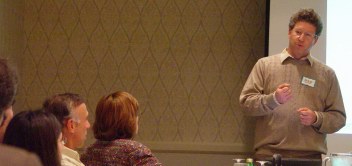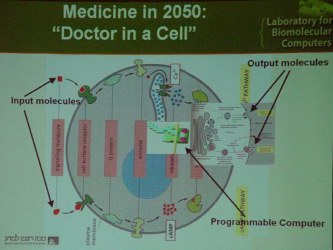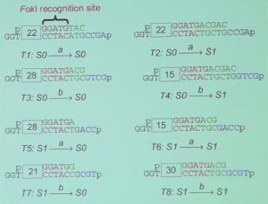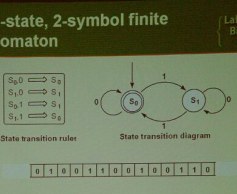danbricklin.com/log
|
||
|
|
Starting December 4, 2003
Happy New Year!, A new memento, Ehud Shapiro's molecular computers
04Dec03
2003_12_04.htm
|
|
|
Happy New Year! [link]
Another year draws to a close. This was a somewhat slower year for blogging here on DanBricklin.com for many reasons. Maybe I'll get to do more next year. I hope so. I like the feeling of a special connection to the rest of the world that blogging brings.
Doing less blogging doesn't mean that I am losing interest in doing it or in believing in its important role in society. I still take pictures at events just in case I get around to blogging. I'm thrilled at how blogging has become more and more influential in a mainstream way for communications, sorting through material on the web, and firsthand reporting. This has been a great year for seeing many of the emerging values of self-expression on the web, from firsthand accounts during war, to political community building, to better and better tools for finding out what others find of interest.
Of course, not writing frequently doesn't mean I'm not reading frequently. Thank you to all the bloggers out there who provide insight and news for us readers while sharing a piece of their lives.
Happy New Year to all!
A new memento [link]
This evening I opened up a holiday card that came today. It was from Vern Raburn, CEO of Eclipse Aviation. Vern, along with Dottie Hall, Tom Byers, and me, co-founded Slate Corporation back in the early 1990's to develop application software for pen computers. He's now head of a company building a revolutionary new small jet plane/taxi. While he loves computers, airplanes were always his big passion.
As I opened the card, I saw it was a somewhat humorous comparison of Santa's reindeer to the upcoming Eclipse 500. Kind of nice. When I opened it all the way up, though, a little piece of paper fell out with a note.
 The inside of the card
  The insert and the postmark
I looked back at the envelope. This card was mailed from Kitty Hawk 100 years to the day after the Wright Brothers' flight. I felt a shiver go down my spine as I felt the connection in my hand to history. (I really did -- not many corporate holiday cards do that.) Must be the engineering historian in me...
This was a very nice added touch to a traditional marketing item. Many of the people associated with Eclipse are avid airplane buffs. What a great gift. It goes in my "save forever" file.
Ehud Shapiro's molecular computers [link]
In addition to going around publicizing Interland's new Platinum offering (as I wrote up in my essay) and other work for Interland, I occasionally get to go to some conferences and other events. Unfortunately, I haven't had time to write them up. I do, though, often take pictures that will help me remember what happened and allow me to write them up when I get around to it.
One event was a presentation a few weeks ago to a group of computer industry people by Ehud Shapiro. The meeting was sponsored by the institution where he works, the Weizmann Institute of Science, in Rehovot, Israel. I have a sweet spot in my heart for the place ever since I spent a wonderful summer there in 1970 and shared an office working with computers with my cousin David Levin and Michael Hammer (Michael was a grad student at MIT and is now a famous consultant). Weizmann is a major multidisciplinary research institution. Some of the commercial products that came from their research can be seen on this page from their Yeda commercial arm.
 Ehud Shapiro answering a question
Ehud is a computer scientist by training, and was a founder of Ubique, and a precursor to today's IM that was sold to AOL. He became intrigued by the idea of doing computation using biological molecules instead of integrated circuits, and has been working in that field for the last several years at Weizmann.
His initial vision was to use the way RNA and DNA do transcription to make molecules as a mechanism for doing computation. [Note: My understanding of biology and the details here are very minimal. Those that understand biology should be able to figure out what I mean. Computer people should read it all to get the feeling I got.] He built a physical model that worked kind of like biological transcription and that implemented a Turing machine -- enough to do most any computation. He then hooked up with people at Weizmann who knew the biological side, and started working at the molecular level to make a "real" molecular-based programmable machine.
The vision is to have DNA molecules that enter cells and run "programs", changing other DNA and RNA into something determined by a "program". For example, in the far future, this would lead to programs that find defective genes and fix them.
 The "vision" as a slide
They figured out how to make a process that implemented a simple 2-state machine, not a full Turing machine. Each "input" was one sequence of molecules on the DNA strand, chosen from two configurations (giving either input A or input B). As each sequence was "read", it was cleaved off from the strand in a way that set the next state (either state S0 or state S1), which is sent along to the next step along with the next input from the strand. Eventually the reading would stop at the end of the strand or a "stop" sequence. The final state could then be read. (Maybe this illustration from one of his papers helps.) The process they figured out does not use up much energy. In traditional computers, "erasing" data decreases entropy which uses energy. In this scheme, they are increasing entropy while running since they break up molecules, so produce the energy needed to continue running.
 Encoding state machine rules in molecules
 2-state 2-symbol automaton to determine if there are an even or odd number of 1's in a sequence
The process they created takes many minutes to occur in a test tube, but there are lots of molecules... They have demonstrated 3*10**12 automata ("machines")/microliter running in parallel on potentially distinct inputs in a small vial at room temperature, with a combined rate of computation of 10**9 transitions per second/microliter, with an accuracy of >= 99.9% per transition, consuming less than 10**-8 watt/microliter.
Really neat. Eventually, this could lead to "medicine" programs that go into cells and do all sorts of helpful things.
Ehud, as a computer scientist, stumbled onto an interesting observation. Biologists don't "get" programming, but programmers do. Something even as simple as a 2-state machine can run very interesting, very powerful "programs". A programmer can come up with things you can do that don't fit into the normal biochemical-process style of thinking of biochemists. There is some mindset thing about knowing how to make really complex and powerful "machines" out of sequences of a few very simple instructions. (I remember programming an entire word processing system on that "Model-T" of computers, the DEC PDP-8, which only had 8 different instructions.) This is exciting, because now that programmers are involved, they can do biological advances that weren't foreseen. Ehud found it refreshing to talk to a group that was mainly computer people and not biologists, and who could share and understand his excitement.
This reminded me of the transition from analog computing and analog machines to digital ones. By simplifying the electronics to only have two values (representing 1 and 0), rather than making a smooth linear or nonlinear analog system, you can cut all sorts of corners in design and then build up from simple building blocks. Eventually the digital systems outperformed the analog ones even in some very complex operations, as we're still seeing today with audio, video, communications, and others fields.
Understanding how "fertile" a programmable system can be (vs. a fixed-function one) is natural to most computer people. We always find it strange that other people don't understand that fact as intuitively. Here we may have another example of where "thinking like a programmer" may really help the world.
|
||
|
© Copyright 1999-2018 by Daniel Bricklin
All Rights Reserved.
See disclaimer on home page.
|
||